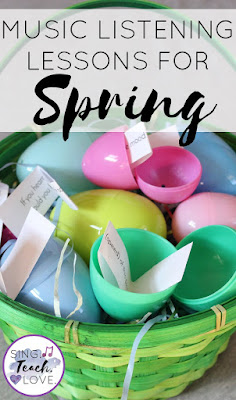Music & Movement
Butterfly Etude, Frederic Chopin
I love this
piece because it’s the epitome of spring: lively, light, and cheery. I mostly let
students just explore the motions and pathways of a butterfly, which
is also a wonderful way to draw their attention to symmetrical movement.
Here is my
sequence; each number is a single listen through the song. I generally do 2 listens per class, which allows the lesson to stretch over 3-4 class periods. (Sometimes I repeat an activity to allow for more exploration or fun!)
- 1st time through: Sit down and fold hands like a butterfly; follow the music with your hands. (Short discussion after about thoughts & ideas)
- 2nd time: Move around the room like a butterfly. Put some of the movements you explored with your hands into your whole body.
- 3rd time: Each student gets two scarves, one in each hand. Move around the room like a butterfly and use the scarves to extend those movements.
- 4th time: Move in small groups while others watch. Ask the observing students what they noticed and what they liked.
- 5th time: Each student receives a butterfly net. Use the nets to feel the larger phrases of the piece, arching dramatically as you follow those big phrase lines. You will probably want to join them to help demonstrate.
- 6th time: Split into two groups, one with the butterfly scarves and one with the nets. Then switch and do it again! Pro tip: Keep these two groups on opposite sides of the room or you will end up with someone’s net on someone else’s head. But you already knew that…
Mystery Song
Flight of the Bumblebee, Nikolai Rimsky-Korsakov
This is my
very favorite listening activity for just about any piece of music. It is versatile, engaging, and truly higher order thinking. And, it can be done in the last few minutes
of class, or it can be paired with history and a discussion for an entire
lesson.
At its simplest,
I hand students a blank piece of paper and say, “Draw the picture that comes to mind when you hear this piece.”
The Flight
of the Bumblebee is a great piece for this exercise because it has distinct
sounds that will provoke a variety of mental images. Even if they haven’t heard it
before, many of your students will pick up on the idea that this sounds like a
chase or running and some will even think of bees.
I do not
tell students anything about the piece, they are just doing a cold listen.
Typically, I play the piece a few times and allow them time to draw and then I
suggest they give it a name. "If you were
the composer, what would you title this piece?"
The most important
part of this activity is the discussion afterwards. I find that students are
almost always eager to share their artwork and explain what they noticed and
how that translated to their picture.
As you discuss, connect their drawings to the elements of the music like: the quick tempo makes us feel like we are running or the ascending and descending runs in the violins make us picture something flying up and down. Use as much music language and terminology as you can, and eventually they will begin to use it too.
As you discuss, connect their drawings to the elements of the music like: the quick tempo makes us feel like we are running or the ascending and descending runs in the violins make us picture something flying up and down. Use as much music language and terminology as you can, and eventually they will begin to use it too.
Music Listening Egg Hunt
Morning Mood from Peer Gynt Suite, Edvard Greig
An awesome
way to make a regular activity extra fun is to turn it into a
scavenger hunt, and what could be more perfect for spring than an Easter eggs?
I print a list of listening questions on small slips of paper and hide them in eggs around the room. Students hunt quietly for a single egg while they listen to the music; when they find an egg they return to their spot, open the egg, and read the question. After listening through the entire piece, everyone should be back in their spot and it’s time to ask for volunteers to read their question and provide an answer.
I print multiples of each question, so some students will be listening for the
same thing. This fosters meaningful and somewhat organic discussion, because
students will have the same questions but inevitably have different answers. Here are the questions I used for this piece:
- Name one instrument that you heard.
- How would you describe the tempo (speed) of this piece?
- How would you describe the mood (feeling) of this piece?
- What do you hear in the music that reminds you of spring?
- If you heard this song on a movie soundtrack, which movie would you be watching?
Happy
Listening!


















Love the "Morning Mood" with the Easter Eggs!! Thanks for sharing your ideas!
ReplyDeleteYou're welcome Elizabeth! I'm so glad you enjoyed it
DeleteIt is not unusual to have some children who want to learn to play the violin, while other children will have parents who want them to learn how to play the violin. violin
ReplyDeleteThis includes the documented classical traditions of Asian countries outside the influence of western Europe, as well as the folk or indigenous music of various other cultures. שירים יפים בעברית
ReplyDeletesquire affinity strat Thanks for a very interesting blog. What else may I get that kind of info written in such a perfect approach? I’ve a undertaking that I am simply now operating on, and I have been at the look out for such info.
ReplyDelete